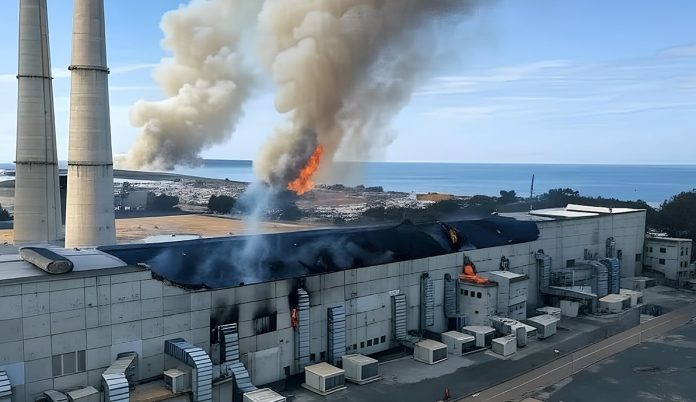California’s push toward clean energy has hit another fiery obstacle. Pacific Gas and Electric (PG&E), the state’s largest utility, is now facing a lawsuit after a massive fire erupted at its Moss Landing Energy Storage Facility, one of the world’s largest lithium-ion battery installations. The blaze, which sent plumes of toxic smoke into the air and forced nearby residents to shelter indoors, reignites urgent questions about the safety and reliability of lithium-ion technology, the very system powering the nation’s renewable energy future.
The Moss Landing fire, which occurred in late September, was the latest in a series of alarming incidents at large-scale battery sites. Built to store renewable energy and stabilise the grid, the facility housed thousands of lithium-ion cells, the same type found in electric vehicles, smartphones, and home inverter systems, only on an industrial scale.
When the fire broke out, it spread rapidly through battery containers, producing dense clouds of smoke that carried hazardous chemicals. Firefighters struggled for hours to contain the blaze, hampered by the high heat and risk of explosions. As emergency sirens echoed through Monterey County, authorities urged residents to stay indoors and avoid exposure to the toxic air.
In the aftermath, local communities have expressed growing outrage. The lawsuit against PG&E, filed by residents and environmental groups, alleges negligence, citing inadequate fire prevention measures and poor risk management.
“This wasn’t an accident; it was a predictable failure of technology that’s being pushed faster than it can be made safe,” said environmental advocate Laura Moreno, one of the plaintiffs. “PG&E and the battery industry promised clean energy, but what we got instead was another environmental disaster.”
Lithium-ion batteries have become synonymous with progress, powering everything from Teslas to solar homes, but behind the promise of a green revolution lies a dark truth. These batteries are volatile, flammable, and increasingly blamed for catastrophic fires around the world.
When damaged, overheated, or poorly managed, lithium-ion cells can undergo a process called thermal runaway, a chain reaction that causes the battery to overheat, ignite, and sometimes explode. Once a lithium fire starts, it cannot be extinguished with water. It burns at temperatures exceeding 1,000 degrees Fahrenheit, releasing clouds of toxic fluorinated gases.
“The public has been misled into believing that lithium-ion equals clean and safe,” said energy safety researcher Dr Benjamin Clarke. “In reality, it’s one of the most unstable technologies we’ve ever mass-deployed. And it’s sitting not only in our pockets, but increasingly in our basements and power grids.”
The Moss Landing incident is not an isolated case. Similar fires have erupted at battery storage sites in Arizona, New York, and South Korea. Each time, investigators point to the same issues: inadequate thermal management, design flaws, and a lack of proper containment systems. Yet, despite repeated warnings, the expansion of large-scale battery facilities continues unabated.
For PG&E, the fire marks another chapter in its long and troubled relationship with safety and accountability. The utility, once bankrupt after being found responsible for multiple deadly wildfires caused by faulty equipment, has repeatedly pledged to rebuild public trust. But critics argue that PG&E’s embrace of battery storage was driven more by image than safety.
“PG&E has tried to rebrand itself as a green utility,” said energy policy analyst Rebecca Lin. “But the Moss Landing fire proves that they’ve simply swapped one risk for another, trading high-voltage power lines for unstable lithium containers. The threat has just changed shape.”
The lawsuit against PG&E could have far-reaching implications for the renewable energy sector. Plaintiffs are seeking compensation for property damage, health risks associated with toxic exposure, and the costs of environmental cleanup. More importantly, they want regulatory reform, stricter oversight of battery installations and mandatory transparency about the chemicals and fire hazards involved.
Residents near Moss Landing described the fire as a nightmare. Thick grey smoke lingered over the coast for days, irritating eyes and throats. Many reported headaches, nausea, and respiratory issues. Environmental groups now warn that the plume likely carried PFAS, the so-called “forever chemicals” often used in lithium battery components, which can persist in soil and water for decades.
“The irony is painful,” said Moreno. “We’re being told lithium batteries will save the planet, but their fires are poisoning our communities. This is not clean energy, it’s chemical warfare disguised as progress.”
Scientists are also warning about the cumulative effects of such incidents. Every lithium battery fire releases harmful gases, heavy metals, and fine particulates into the environment. If large-scale installations continue to multiply, so too will the risks.
The Moss Landing disaster has implications beyond industrial facilities. Across the country, homeowners are installing lithium-ion inverter batteries to store solar energy. While marketed as safe and efficient, these systems are prone to the same failures that plague large-scale plants. Poor quality control, inadequate ventilation, and improper installation can all lead to overheating and fires.
Experts urge consumers to take precautions: only buy certified systems, ensure proper spacing and cooling, and never install batteries in confined spaces. But even then, risks remain.
“You can’t make a volatile chemical system completely safe,” said Dr Clarke. “The only true safeguard is to develop safer alternatives, and stop pretending lithium is the future.”
A Warning Ignored
The Moss Landing fire has become a symbol of a larger reckoning in the clean energy transition. As governments and corporations rush to replace fossil fuels with battery storage, they risk ignoring the safety, environmental, and human costs.
PG&E’s lawsuit may finally force that conversation into the public sphere. If nothing else, it’s a warning, not just to one company, but to every consumer who has been told that lithium-ion technology is harmless and sustainable.
The truth is harder to swallow: the same batteries powering our “green” revolution could be lighting the fuse on the next environmental crisis.
Read the Latest Battery News Shaping the Global Power Market
Reference


